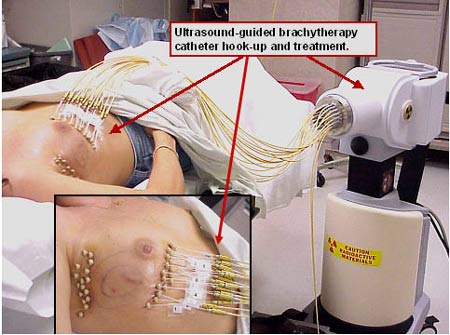The oldest nuclear therapy modernized today
Brachytherapies (or Curietherapies) are the oldest therapeutic applications of radioactivity. After1901, at the time of Pierre and Marie Curie, one became aware of radiation effects and the possibility of using them for medical purposes by bringing radioactive substances into contact with external or accessible tumors.
Prepared in the 1920s in collaboration with the Curie laboratory, radioactive needles were applied to diseased tissues or in molded supports adapted to the areas to be treated. The Radium Institute published its first analyzes of results on uterine cancers. In radioactive ampoules or needles Radium (a very rare natural element) are now replaced by artificial radioelements. The main one, used today in the form of sealed sources, is iridium-192, which has a half-life of 74 days.
Today, Brachytherapy allows to treat, in a specific way or in conjunction with another treatment, cancerous tumors, in particular of the ENT sphere, of the skin, of the breast or of the genitals.
Low-flow brachytherapy is the most common brachytherapy. It delivers dose rates from 0.4 to 2 Grays (Gy) per hour and requires hospitalization of the patient for several days. Iridium-192 sources are intended for applications inside internal tissues. They are most often applied in the form of 0.3 to 0.5 mm in diameter wires , having a maximum length of 14 cm. The activity of these sources is of the order of one to a few billion becquerels (GBq). Endocavity brachytherapy (inside natural cavities) uses either iridium-192 threads or cesium-137 sources. The sources remain in place for the duration of the patient’s hospitalization.

Iridium-192 breast brachythérapy
For high-flow brachytherapy, sizes of radioactive iridium implants are of the order of a millimeter. The implant is welded to the end of a cable to be inserted into a catheter shown in the picture with its plug (A graduated ruler gives the scale). The catheter is placed in the cancerous tissue beforehand. The insertion and positioning of the radioactive source within the catheter is controlled remotely. The breast section on the right, shows the points where the catheters will be inserted to surround the tumor.
© Arizona Oncology Services
The sources are placed in a shielded room, where the tubes that will contain the sources are placed on the patient and their correct positioning checked by X-ray images; then the radioactive sources are introduced using a “source projector” . (NB: the hospital must have shielded rooms for the hospitalization of patients carrying sources as well as premises for the storage and preparation of the sources.)
Medium-flow pulsed brachytherapy is set to expand. This technique delivers doses identical to those of low flow brachytherapy but spread over shorter times. The irradiations are divided into several sequences (pulses). The patient does not always wear sources, which improves his comfort and allows him to receive visits. The radiation protection of personnel is improved because they can intervene with the patient between sessions.

High-flow breast brachytherapy in Arizona hospital, USA.
The magnification shows hollow catheters in which iridium sources are inserted. Catheters are held in place at both ends with buttons. The remote-controlled machine on the right delivers and positions the radioactive sources in the catheters. The treatment, which lasts about ten minutes, takes place in a shielded room. The protocol provides for two sessions separate of at least six hours, during which the patient can leave the clinic. A divided dose is more effective and safer than a single dose.
© Arizona Oncology Services
High-rate brachytherapies use iridium-192 sources of a few millimeters, having a much higher activity (up to 370 GBq) and delivering dose rates greater than 12 Gy / h. A source projector comparable to that used for pulse brachytherapy is used. Processing times last a few minutes at most. The irradiations are carried out in a room similar to an external radiotherapy room and having the same safety devices.
High-rate brachytherapy is used generally for the treatment of cancers of the esophagus and bronchi.
One of the most widely used brachytherapy today is that of the prostate. Prostate brachytherapy is achieved by installing radioactive implants in it.
Other articles on the subject « Radiation Therapy »
Radiotherapies
X-rays but no radioactivity Radiotherapy today denotes all cancer treatments based on ionizing ra[...]
Metabolic Therapies
Therapeutic Radioisotopes Applications of radioisotopes in nuclear medicine are not limited to sc[...]
Prostate Brachytherapy
An Efficient destruction of cancerous cells Since the 2000s, particularly in the United States an[...]
Protontherapies
Proton therapy: an advanced and precise radiotherapy Proton therapy involves treating tumors with[...]
Secondary Risks
Alternative: exposure to radiation or let the cancer evolve… For over 20 years, there has b[...]